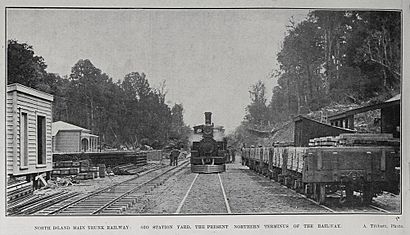Oio railway station facts for kids
Quick facts for kids
Oio railway station
|
|||||||||||
|---|---|---|---|---|---|---|---|---|---|---|---|

Oio station yard in 1906
|
|||||||||||
| Location | New Zealand | ||||||||||
| Coordinates | 39°03′13″S 175°22′47″E / 39.053594°S 175.379797°E | ||||||||||
| Elevation | 465 m (1,526 ft) | ||||||||||
| Line(s) | North Island Main Trunk | ||||||||||
| Distance | Wellington 367.19 km (228.16 mi) | ||||||||||
| History | |||||||||||
| Opened | 1905 | ||||||||||
| Closed | 28 August 1972 | ||||||||||
| Electrified | June 1988 | ||||||||||
| Services | |||||||||||
|
|||||||||||
Oio was a railway station located on the North Island Main Trunk line in New Zealand. It served a small settlement called Oio, which was just north of the station. The station was about 8.29 kilometers (5.15 miles) north of Raurimu and 5.64 kilometers (3.50 miles) south of Ōwhango.
Oio was one of several temporary "railheads" along the railway line. A railhead is the point where the railway track ends while construction is still happening. Work on the Oio section of the line took place between 1904 and 1908.
Contents
Building the Oio Railway Station
The Public Works Department was in charge of building the railway. They handed over the Oio station to the NZ Railways on 9 November 1908.
Even before the station was officially handed over, a lot of work was happening. A road was built in 1904, and by March 1905, the area for the station yard was being prepared. By April 1906, Oio was the railhead, meaning it was the end of the completed railway line. There was even a special pumice road connecting Oio to Makatote.
Trains were already bringing in materials like ballast (stones used under railway tracks). Tracks were being laid, and the line stretched halfway to Raurimu. The track even had to be moved because of a landslide! Workers were also busy building bridges over streams like the Waikohatu River and the Piopiotea Stream. Large metal parts for the Piopiotea bridge were made far away in Auckland. By May 1907, goods could be sent by train all the way to Raurimu.
What the Station Looked Like
By March 1908, Oio station had many important features. It had a "passing loop," which is an extra section of track that allows trains to pass each other. This loop was long enough for 58 wagons!
The station also had a platform for passengers, a small shelter shed with a lobby and storage, and a special office for the "tablet" system, which helped control train movements safely. For goods, there was a loading bank, yards and pens for cattle, and a goods shed with a verandah. There were also toilets and a large water tank that supplied water to the station. By November 1908, a proper station building, known as a "6th class station," was added, along with a path for carts to reach the platform.
A Home for Railway Workers
As the railway grew, houses were built for the railway workers and their families. These homes were constructed between 1908 and 1926. By 1916, the population of Oio had reached 102 people, showing how important the railway was to the community.
Interesting Facts About Oio
Oio is special because it was one of only three railway stations in New Zealand with a very short, three-letter name. The other two were Ava in Wellington and Tui in the Nelson Region.
The name "Oio" might come from a Māori word. It could be a shorter version of "ioio," which means muscular, or "puioio," which refers to a tree knot.
Oio station eventually closed to passengers on 5 July 1970. It then closed completely for freight services on 28 August 1972.
Manson's Siding: A Timber Story
A "siding" is a short section of railway track connected to the main line, often used for loading or unloading goods. Between 1915 and 1917, a company called Manson & Clark built a siding about 2 miles and 28 chains (about 3.8 kilometers) south of Oio. This siding was used to serve their timber mill, which processed wood. The mill even had its own small railway, called a "tramway," that ran to the northwest.
The timber mill, which was later known as United Sawmills, unfortunately burned down in 1937. Because the mill was no longer operating, the siding was closed on 3 April 1949. Even though the siding and mill are gone, the name "Manson's" still exists as a road and a local area today.
Images for kids


